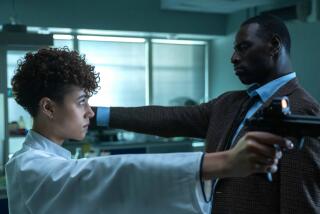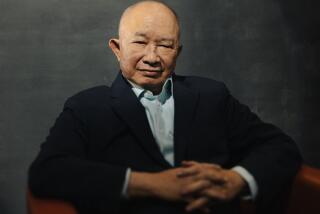Shaw Bros. Returning Action to Hong Kong
- Share via
HONG KONG — At the center of an ambitious bid to revitalize one of Asia’s great movie capitals, the venerable Shaw Bros. Studios is emerging from two decades of dormancy to build Hong Kong’s largest movie studio.
Coupled with the release on video this year of classic Shaw Bros. films--long awaited by a loyal cult following--the studio’s reemergence could help put in perspective Hong Kong cinema’s popularity and influence in Hollywood.
Whether the ventures will be successful financially or herald the revival of Hong Kong’s long-depressed film industry remains to be seen. The local cinema, which launched Bruce Lee and Jackie Chan to international stardom, has succumbed to competition from pirated video and television, and theatrical releases here often are unprofitable.
The expanding media empire of Run Run Shaw, the firm’s 94-year-old patriarch, will require new content, especially new movies.
Shaw Bros. and its sister company, TVB, Hong Kong’s largest terrestrial television broadcaster, recently won one of five potentially lucrative government licenses to launch pay-TV services in this former British colony. They already have cable and satellite-TV systems aimed at Chinese-language communities in Asia, Europe and North America.
The new Movie City, being built at Tseung Kwan O on the eastern end of the Kowloon Peninsula, is expected to cost more than $100 million and include more than 450,000 square feet of state-of-the-art sound stages, post-production facilities and screening rooms.
Shaw Bros. will hold a 35% share in the project, with a consortium of investors holding the rest. After completing the facility in 2005, Shaw Bros. plans to release about 20 new films a year.
During its 1960s and ‘70s heyday, Shaw Bros. had the largest privately owned movie studio in the world, churning out 40 movies annually. Some directors made three or four films a year.
The tight production deadlines and budgets and experienced crews of Hong Kong’s film industry helped it to rank second to Hollywood in film exports. The box-office take of American movies in Hong Kong cinemas did not surpass that of local films until 1997.
The Shaw Bros. organization traces its roots to Shanghai in the 1920s, when Runje, Runme and Run Run Shaw, sons of a wealthy textile merchant, began producing silent movies through their Unique Film Productions Co.
They later moved their operations to Singapore. By the late 1930s, they had a circuit of more than 100 cinemas across Southeast Asia, as well as several amusement parks and dance halls.
The new Movie City will not be far from Movie Town, Shaw Bros.’ home. Movie Town represented Shaw Bros.’ effort during its golden years to match Hollywood production standards. At the time, the facility was the best in Asia, and a glossy studio look, with ancient Chinese towns and ornate courtroom settings, became a hallmark of Shaw Bros. films.
Shaw Bros. needs to make new movies in part because last year it sold a film library of some 800 movies--the world’s largest Chinese-language film collection--to the Malaysian media conglomerate Usaha Tegas Sdn. Bhd., also known as UTSB.
Celestial Pictures, UTSB’s Hong Kong subsidiary, is busy restoring original prints, brightening faded colors and filling in broken frames in preparation for their release this summer on DVD and other video formats. Celestial is negotiating with potential video distributors.
UTSB plans to use the library as the foundation of a Chinese-language movie channel, to be distributed to Chinese communities worldwide. The channel plans to begin operations this year.
Celestial plans to issue 20 remastered movies a month, “enough for a Shaw Bros. rack” in video stores, said Shirley Chung, Celestial’s corporate affairs general manager. This would include box sets for Shaw’s various genres, including historical dramas, ghost stories, swordplay epics and erotic films.
“The Shaw Bros. library is so rich in genre, you could study it for ages,” Chung said.
Watching the old Shaw Bros. films is bound to prompt comparisons with movies being made in Hollywood by Hong Kong directors and actors, many of whom got their start at Shaw Bros. studios.
The foremost example probably is veteran action-film director John Woo, whose themes of heroism and loyalty and carefully composed action shots owe much to Chang Cheh, his mentor. Chang directed more than 60 martial arts films for Shaw Bros. during its golden era, including “The One-Armed Swordsman” in 1967 and “Five Deadly Venoms” in 1978.
Above all, a retrospective look at Shaw Bros. “old school” martial arts films shows off one of Hong Kong’s greatest strengths: synthesizing the cultures of East and West.
During the 1960s and ‘70s, Run Run Shaw was determined to create a new style of martial arts movie. He wanted his “martial arts century” to deliver more realistic action and psychological detail than earlier Chinese films, which reflected the influences of Peking opera in their action and character portrayal.
Shaw advised his directors on which new foreign films to watch for ideas. Chang, for example, was quick to absorb the techniques and styles of such directors as Sam Peckinpah and Akira Kurosawa.
One of Chang’s martial arts choreographers, Lau Kar-Leung, went on to direct some of Shaw’s most popular films, including the 1978 cult favorite “36th Chamber of Shaolin.”
These directors, said film scholar David Bordwell at the University of Wisconsin-Madison, created a film language that “communicated the qualities of grace and force so effectively that you almost feel the kinetic impact, not just from the martial arts moves but also through the framing and cutting” of the film.
Without the budgets or technology for flashy special effects, the Shaw films relied on their actors’ physical prowess and directors’ resourceful camera work and hiding of wires and trampolines.
“When you look at the old pictures, you have to wonder how we made them, without computers or anything,” said Lawrence Wong, director of film production and a veteran of numerous Shaw Bros. classics.
Fight scenes in “old school” kung fu movies typically used long, carefully composed shots, giving a clear view of the martial arts techniques, with their staccato rhythm of explosive punches, kicks and blocks.
Today, Bordwell said, many Hollywood directors “will hire a Hong Kong choreographer, but then shoot and cut the scene in a way that’s just visual gibberish--when the Hong Kong filmmakers come over to America, mostly I think their work is not as interesting, partly because of those shooting routines.”
Also lacking in the current Hong Kong-influenced cinema are traditions of lore and literature, on which the Shaw Bros. movies drew. Although exotic and unfamiliar to Western audiences, the references are well known to Chinese viewers.
These sources include epic novels such as “Outlaws of the Marsh,” the classic sleuthing tales of Judge Bao and the martial arts dramas of modern author Louis Cha. They also drew on history, from the Shaolin Temple and anti-Manchu secret societies to the Boxer Rebellion of 1900.
Chinese viewers also quickly recognize the codes of loyalty and honor among fighters of the “martial forest,” as well as the Taoist philosophy that the superior warrior wins without fighting, defusing conflicts without having to unleash his mastery of martial technique.
Although the use by many martial arts films of these cultural and ethical contexts was sometimes exploitative--an excuse for bloody combat--it also arguably is a redeeming feature amid otherwise gratuitous violence.
U.S. movies that use martial arts choreography contain little or no reference to discipline, humility or other aspects of the “martial virtues” or the hard work needed to build martial skills. Characters in American films just “know kung fu,” as Keanu Reeves discovers after he has the skills programmed into him in “The Matrix.”
This cultural disconnect, aggravated by the hilariously bad dubbing endemic to the genre, contributed to martial arts movies’ reputation among mainstream foreign audiences as little more than gore and kitsch--in other words, cult fare.
The cult status, Bordwell said, was reinforced by distribution patterns. During the 1970s, the movies played mostly at inner-city theaters and other down-market venues under the radar of mass audiences and critics, cross-fertilizing other genres and subcultures, from “blaxploitation” and horror films to rap and reggae music.
More to Read
The biggest entertainment stories
Get our big stories about Hollywood, film, television, music, arts, culture and more right in your inbox as soon as they publish.
You may occasionally receive promotional content from the Los Angeles Times.










